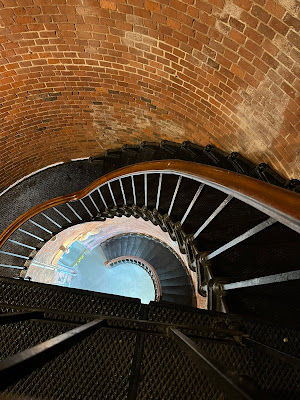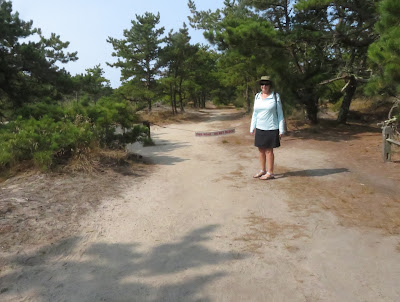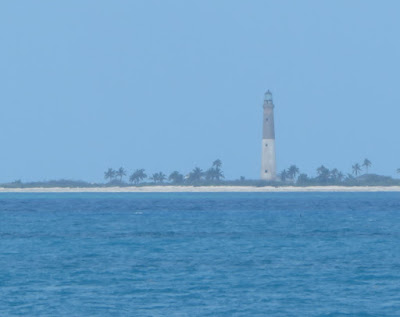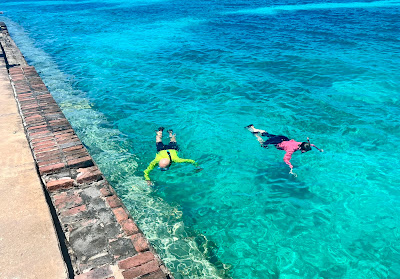 |
| Getting ready to head out |
The interior of Cape Cod is pock marked with about 365,
round(ish), fresh-water ponds called kettle ponds. They were formed when the ice sheet that
formed Cape Cod retreated 18,000 years ago.
The ice sheet left behind great chunks of ice, that slowly melted and
created deep ponds whose bottoms intersected with the fresh water aquifer. The ponds have no in-flow sources of water, and only a
few have an out-flow. They are
replenished by rain water and the water table.
 |
| We explored Gull, Higgins and Williams Ponds |
We signed up for a National Park Ranger-led kayak paddle
across three of these kettle ponds. The
trips are very popular, you can only sign up for them starting a week in
advance, and they usually fill up the first day the list is open.
 |
| Beautiful tree-lined Gull Pond |
We met at Gull Pond, which has a public parking lot, many of
the kettle ponds do not have public access.
It was the first day of what was to become a 3+-day rain and wind storm. We dressed in our kayak gear covered with
rain pants and coats. Only 5 of us
showed up - 6 others had dropped out.
We were accompanied by a Ranger and a volunteer guide.
 |
| Gull Pond |
Gull Pond is a beautiful, small, round lake. It is surrounded with trees and a few summer
cottages. Some of the cottages have
small boats pulled up on shore. Back in
the day, summer visitors came to Cape Cod to stay on the kettle ponds. No one went to the beach and ocean except to fish
or collect seaweed for the garden in those days. After
all, the ocean was full of seals and great white sharks, and was dangerous
.[Note: the ocean is still full of seals, sharks and danger, just now days
folks WANT to be on the beach and swim in the ocean.]
After the National Seashore was founded in 1961, no new
dwellings were built within the seashore boundaries. So, no new cottages will ever be built on
these kettle ponds. In 1961, there were
almost no trees on Cape Cod. It had been
deforested for lumber for ships, buildings and fuel. Under the National Seashore protection,
forests have returned, and the trees are plentiful. Cottages that once had a clear view of the
water, now peek at it through the trees.
 |
| Gull Pond/Higgins Pond portage |
We dragged our kayaks through a narrow sluice way between
Gull Pond and the smaller Higgins Pond. Higgins Pond is also connected with Herring
Pond, which is connected via the Herring River to Cape Cod Bay. Herring travel up the river to spawn in these
freshwater ponds each Spring.
 |
| Water lillies approaching the Higgins/Williams portage |
Higgins Pond is lined with lovely water lilies, with a few
closed blossoms left in mid-September.
Higgins Pond has regular summer cottages and a few Cape Cod Modern
Houses built around 1960. These Bauhaus
influenced houses were built with cheap or found materials. They are boxy with simple lines, and large windows
overlooking the ponds. There are seven
within the National Seashore boundaries, and a local Trust is buying and
restoring them. Some can now be rented from
the Trust as vacation rentals. We could
see the few on this pond through the trees.
 |
| Late, late summer bloom |
From Higgins Pond we made a portage over a narrow sluice to
even tinier Williams Pond. Williams Pond
has even more water lilies. The detritus
from the water lillies has been accumulating on the bottom, and Williams Pond is no longer as
deep as it once was. You can see along
its banks the 18th century home of John Newcomb, a Wellfleet MA
oysterman. Henry David Thoreau describes
staying with Newcomb in 1849 in his book Cape Cod.
 |
| Sorry for the water on the camera lens in these photos - it was raining |
While we were in Higgins Pond, we could hear the surf crashing on the beach. It sounded like it was almost on the other side of the trees. It is always fun to be out paddling on the water, even in winds and heavy rain. As we write this 2 days later, our leather kayak gloves are still wet, hanging from the shower curtain rod in the motorhome.






























































